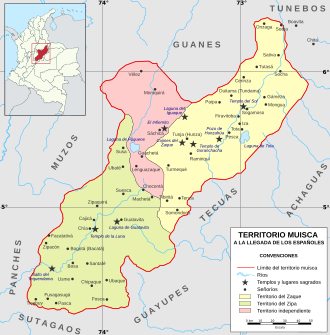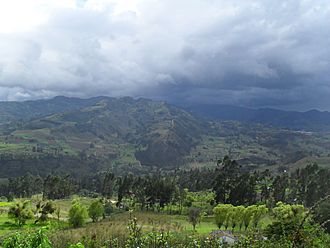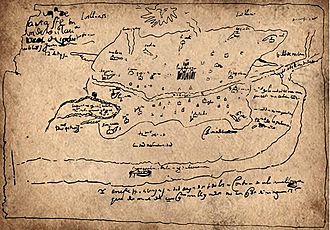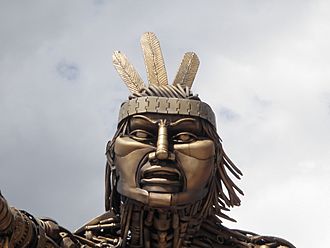Diego de Torres y Moyachoque facts for kids
Quick facts for kids
Diego de Torres y Moyachoque
|
|
|---|---|
| cacique | |
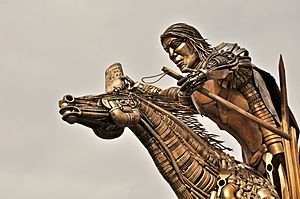
Monument of Diego de Torres located at Turmequé's main square.
|
|
| Reign | 1571–1590 |
| Predecessor | Maternal uncle; Moyachoque |
| Born | 1549 Tunja, New Kingdom of Granada |
| Died | 4 April 1590 (aged 40–41) Madrid, Crown of Spain |
| Queen | Juana de Oropesa |
| Issue | Beatriz de Torre(s) y Moyachoque (sister) Pedro de Torre(s) (half-brother) María de Herrezuelo (half-sister) |
| Father | Juan de Torre(s) |
| Mother | Catalina Moyachoque |
| Memorials | Main square of Turmequé |
Diego de Torres y Moyachoque (born in Tunja, New Kingdom of Granada in 1549 – died in Madrid, Spain on April 4, 1590) was an important leader, known as a cacique, of Turmequé. He led his people from 1571 until his death.
Diego was a mestizo, meaning he had parents from different backgrounds. His father was a Spanish conquistador, and his mother was a noble from the Muisca people. He is famous for standing up for the Muisca people. He fought against the unfair treatment they received from Spanish settlers, especially from his half-brother, Pedro de Torres.
Diego de Torres y Moyachoque was also the first person to draw maps of the lands around Santa Fe de Bogotá. This was the capital of the New Kingdom of Granada. He traveled to Spain twice to tell King Felipe II about the Muisca people's problems. He later stayed in Madrid, got married, and died there in 1590.
Contents
His Early Life and Education
Diego de Torres y Moyachoque was born in 1549 in Tunja. This city was once the capital of the central Muisca Confederation, known as Hunza. His father was a Spanish conquistador named Juan de Torre(s). His mother was Catalina Moyachoque, the older sister of the previous cacique. Catalina was about 41 years old when Diego was born. He had a sister named Beatriz and two half-siblings, María and Pedro de Torre.
Diego went to a special school for mestizo children of conquistadors. It was set up by Diego de Aquila. Later, he studied at the Dominican Convent in Tunja. There, he learned grammar, religion, morals, and law. He was also very good at horse-riding and was an excellent archer.
Becoming a Leader
Diego became the cacique of Turmequé in 1571. He was about 21 or 22 years old when his uncle, the former cacique, passed away. Diego called himself the cacique cristiano, which means "Christian cacique".
The Muisca Confederation was mostly taken over by the Spanish between 1537 and 1540. The town of Turmequé, about 53 kilometers (33 miles) from Tunja, was taken by the main conquistador, Gonzalo Jiménez de Quesada, in 1537.
Fighting for His People's Rights
In 1574, Diego had a big disagreement with the Spanish official in charge of Turmequé. This official was his half-brother, Pedro de Torres. The problem was how Pedro was treating the native people under the encomienda system. This system forced indigenous people to work for the Spanish.
Diego de Torres was joined by Alonso de Silva, another mestizo leader from Tibasosa. Together, they resisted the unfair treatment.
First Trip to Spain
In 1575, Diego de Torres y Moyachoque decided to travel to Spain. He wanted to give the King of Spain a list of demands for the rights of the native people of Turmequé. On his way, he got stuck in Santo Domingo, the capital of the Caribbean. He stayed there for almost three years. During this time, he studied the writings of Bartolomé de las Casas, who was a defender of indigenous rights.
Diego finally arrived in Madrid in 1577. In Spain, he became friends with Juan Bautista de Monzón. They both traveled back to South America. De Monzón was the new official sent to check on the colony. When they arrived, Spanish settlers accused both men of working against the Spanish Crown. Diego de Torres y Moyachoque was even sentenced to death. He quickly ran away into the mountains of the Altiplano Cundiboyacense. But he later returned to Turmequé.
In 1578, Diego made the first map of the Bogotá savanna. This map showed Santa Fe de Bogotá and the towns around it. It also included the Bogotá River and the Sué mountains, which rise over the Llanos Orientales.
Second Trip to Spain
In 1581, a new official, Juan Prieto de Orellana, arrived from Spain. Diego de Torres presented himself to these new Spanish rulers. He was then sent to Spain again.
In 1584, he gave King Felipe II his "Memoria de los Agravios". This was a report about the mistreatment of the Muisca people. During these meetings, Diego de Torres y Moyachoque was allowed to sit instead of kneeling. This was a special honor for visitors to the Spanish King.
He was cleared of the charges against him. He married Juana de Oropesa and lived in Madrid. He died in the Spanish capital on April 4, 1590, when he was 40 years old.
His Legacy
Even though Diego de Torres y Moyachoque was of mixed heritage and learned Spanish customs, he is seen as one of the most important people from Colombia in the 1500s. In Turmequé, there is a monument built to honor the Muisca people and his memory.
Images for kids
See also
 In Spanish: Diego de Torres y Moyachoque para niños
In Spanish: Diego de Torres y Moyachoque para niños
- Spanish conquest of the Muisca
- Muisca rulers, history of Colombia


